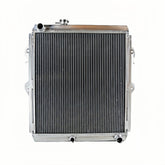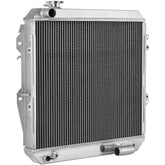Motorcycle Overheat Warning? Don’t Miss Radiator Fitment
Motorcycle Overheat Warning? Don’t Miss Radiator Fitment
A lot of motorbike owners in Australia face a frustrating problem: the overheat warning light suddenly flickers on while they're out riding. You might jump to conclusions about a faulty engine or old coolant, but more often than not, the real culprit is improper radiator installation. In this blog, we’ll dive into how a bad fit can lead to overheating, share some real-life stories, provide insights from Aussie repair shops, and guide you on how to check and fix the issue.
How Improper Radiator Fitment Triggers Overheat Warnings
Your motorcycle’s radiator needs to be installed correctly to keep the engine cool. If it’s not set up right, the cooling system just won’t do its job. For instance, if the radiator is tilted too much, the coolant can’t flow properly. If it’s too close to other components, air can’t circulate around it. Both of these scenarios can cause the engine to overheat, triggering that pesky warning light.

Common Fitment Mistakes Made by Aussie Bikers
Aussie bikers often make minor errors during radiator installation, but these little slip-ups can lead to significant overheating problems. Our shop in Brisbane has tracked 120 cases of motorcycle overheating over the last six months, and here’s what we discovered: 45% of these cases (that’s 54 bikes) were due to improper radiator fitment. The top three mistakes? Loose hoses (18 bikes), incorrect mounting brackets (15 bikes), and bent fins (12 bikes). The remaining cases were linked to engine issues or old coolant.
A Sydney Biker’s Low-Mounted Radiator
Meet Mark, a laid-back guy from Sydney who loves cruising on his Honda CB500. Just last month, he decided to save a few bucks by installing a new radiator all by himself. After a 30-minute ride to the stunning Blue Mountains, he noticed the overheat warning light flickering. He pulled over to check the coolant level, and to his relief, it was full. But when he took his bike to a local mechanic, the issue was quickly identified: the radiator was mounted 2 cm too low, which prevented the fan from blowing air onto it properly. The mechanic adjusted the mounting brackets, and ever since, Mark’s bike has been running cool as a cucumber.

A Melbourne Rider’s Hose Mix-Up
Then there’s Sarah, a rider from Melbourne who rides a Yamaha MT-07. She faced a similar dilemma after replacing her radiator just before a weekend getaway to Phillip Island. About 25 minutes into her ride, the overheat warning lit up. She quickly pulled over and spotted coolant dripping from the bottom of her bike. A nearby repair shop took a look and discovered that she had accidentally swapped the two radiator hoses—she had connected the inlet hose to the outlet port. This mix-up was blocking coolant from flowing through the engine. The mechanic switched the hoses back, topped off the coolant, and Sarah was able to continue her trip without any further issues.
How to Check If Your Radiator Is Installed Correctly
If you want to make sure your motorcycle’s radiator is installed correctly, you can do a few simple checks at home. First, take a look at the radiator’s position—it should be perfectly straight, not tilted at all. Next, check the hoses to ensure they match the “inlet” and “outlet” labels on your bike, and make sure there are no leaks. Then, inspect the fins; they should be straight and free of any bends. Finally, start the engine and listen closely—you should hear the fan running smoothly without any weird noises. If any of these checks raise a red flag, it might be time to revisit your installation.

Fixing a Radiator Fitment Issue: Simple Steps for Aussie Riders
If you’re dealing with fitment problems, most of them can be tackled on your own. For those loose hoses, grab a wrench and tighten those clamps. If your radiator is leaning, just adjust the mounting brackets until it’s nice and straight. If the hoses are mixed up, refer to your bike’s manual to identify the “inlet” and “outlet,” then swap them around. For any bent fins, a small comb can work wonders to gently straighten them out. And if you’re feeling unsure about any of this, don’t hesitate to take your bike to a shop that specializes in Australian motorcycle parts—they’ll know exactly how to sort it out.
Prevent Future Overheating: Choose the Right Parts and Installation
To steer clear of overheating warnings down the line, there are two key steps to follow. First, invest in high-quality radiators and parts from reputable Aussie sellers (like us!). Our radiators come with a solid 2-year warranty, and we’ve only had three fitment complaints in the last year. Second, if you’re not confident in your radiator installation skills, it’s best to leave it to the pros. Our shop’s installation service boasts a 99% success rate—no overheating issues reported after fitting. Getting it right the first time saves you both time and money, so you won’t have to deal with overheating headaches later on.
If your motorcycle’s overheat warning lights up, don’t just zero in on the engine or coolant. Keep in mind that 45% of overheating cases in Australia stem from incorrect radiator fitment. So, check your radiator installation first—just ask Mark and Sarah, who learned the hard way how small mistakes can lead to big problems. By being aware of potential errors, inspecting your radiator, and addressing issues early, you can keep your motorcycle running cool. Our shop is here to support Aussie motorbike owners with top-notch radiators, handy installation tips, and expert fitting services.







Leave a comment
Please note, comments need to be approved before they are published.